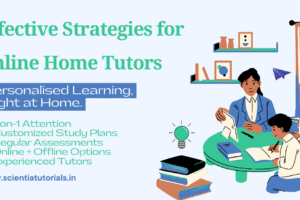Fostering Imagination: Teaching Tips for Home Tutors on Encouraging Creative Thinking in Home Tutoring Sessions
Introduction
In today’s rapidly evolving world, creative thinking is more essential than ever. It fuels innovation, problem-solving, and the ability to adapt to new situations. For home tutors, fostering creativity in students not only enhances their academic performance but also equips them with essential skills for future challenges. This article explores effective strategies and teaching tips for home tutors to encourage creative thinking during tutoring sessions.
Understanding Creative Thinking
Creative thinking involves the ability to look at problems or situations from a fresh perspective, generating new ideas and solutions. It includes skills such as:
- Divergent Thinking: The capacity to generate many ideas or solutions to a problem.
- Critical Thinking: The ability to analyze and evaluate an issue to form a judgment.
- Imaginative Thinking: The capability to envision possibilities that may not be immediately obvious.
Recognizing the importance of these skills can help tutors design their sessions to nurture creativity in their students.
The Importance of Encouraging Creative Thinking
- Enhances Problem-Solving Skills: Students who engage in creative thinking are better equipped to tackle complex problems. They learn to approach issues from multiple angles and consider innovative solutions.
- Boosts Confidence: Encouraging students to express their ideas freely fosters self-confidence. As they become more comfortable with their creative instincts, they are likely to take more risks in their learning.
- Promotes Engagement: Creative activities make learning enjoyable. When students are engaged, they are more likely to absorb information and retain it.
- Fosters a Lifelong Love for Learning: By nurturing creativity, tutors can instill a passion for exploration and discovery that lasts a lifetime.
Tips for Home Tutors to Encourage Creative Thinking
1. Create a Supportive Environment
Encouragement and Acceptance
- Foster an Open Atmosphere: Create a safe space where students feel comfortable sharing their ideas without fear of judgment. Encourage them to express themselves freely.
- Validate Ideas: Acknowledge and validate the students’ thoughts and contributions. Even if an idea seems unconventional, appreciation can motivate them to think outside the box.
Physical Space
- Design a Creative Learning Space: Organize the tutoring area to promote creativity. Use bright colors, comfortable seating, and access to various materials like art supplies and educational games.
- Incorporate Flexible Seating: Allow students to choose their seating arrangements. Options like bean bags, cushions, or standing desks can make them feel more at ease and creative.
2. Use Diverse Teaching Methods
Incorporate Different Learning Styles
- Visual Learning: Use diagrams, charts, and videos to present information visually. This approach can help students conceptualize ideas better.
- Kinesthetic Learning: Integrate hands-on activities and experiments. For example, conducting science experiments or engaging in art projects encourages active participation.
- Auditory Learning: Encourage discussions, storytelling, and debates. Verbal expression helps students articulate their creative thoughts.
Integrate Technology
- Educational Apps and Tools: Utilize apps and online platforms that promote creativity, such as Canva for design projects or coding games that allow students to build their own games.
- Virtual Field Trips: Leverage virtual reality or video tours of museums, art galleries, or historical sites. These experiences can inspire students and spark their creativity.
3. Encourage Exploration and Curiosity
Ask Open-Ended Questions
- Promote Discussion: Use open-ended questions to encourage deeper thinking. Instead of asking yes/no questions, frame inquiries that require elaboration. For example, “What do you think would happen if…?” or “How might we solve this problem differently?”
- Facilitate Group Discussions: Encourage students to discuss their ideas in groups. Collaboration fosters diverse viewpoints, leading to richer creative outputs.
Introduce Creative Challenges
- Problem-Solving Activities: Present students with real-life problems and ask them to brainstorm solutions. This could involve designing a new product, improving a service, or finding ways to address environmental issues.
- Creative Projects: Assign projects that allow students to explore topics in depth. For example, they could create a short film, write a story, or develop a marketing campaign for a fictional product.
4. Integrate Arts and Crafts
Hands-On Creative Activities
- Art Projects: Use painting, drawing, or crafting to encourage self-expression. Art can help students convey their ideas visually and develop their unique style.
- Performing Arts: Encourage students to engage in drama, music, or dance. These activities stimulate creativity and enhance their ability to express themselves in different mediums.
Creative Writing Exercises
- Story Starters: Provide intriguing story starters or prompts that spark imagination. Encourage students to continue the story in their own way.
- Poetry and Lyrics: Explore different forms of poetry or song lyrics. Students can write their own poems or songs, allowing them to play with language creatively.
5. Foster Reflection and Evaluation
Encourage Self-Assessment
- Reflection Journals: Have students maintain journals where they reflect on their learning experiences and creative processes. Encourage them to jot down their thoughts, ideas, and feelings about their work.
- Goal Setting: Help students set personal creative goals. This encourages them to take ownership of their learning and evaluate their progress.
Provide Constructive Feedback
- Focus on Growth: When giving feedback, highlight areas for improvement while acknowledging strengths. This balanced approach encourages students to view feedback as a positive tool for growth.
- Encourage Peer Review: Allow students to review each other’s work and provide constructive feedback. This promotes collaboration and fosters a sense of community.
6. Celebrate Creativity
Showcase Work
- Exhibit Student Work: Create opportunities to display students’ creative projects, whether through a small exhibition at home or sharing them online. This recognition can boost confidence and motivate further creative endeavors.
- Host Creative Competitions: Organize friendly competitions where students can showcase their skills. This could include art contests, writing challenges, or science fairs.
Celebrate Efforts
- Reward Creativity: Implement a reward system to celebrate creative efforts. Whether it’s a small treat, certificate, or praise, recognizing students’ hard work reinforces their motivation.
- Encourage Sharing: Provide opportunities for students to share their creative work with family and friends. This recognition can motivate them to pursue their interests further.
Conclusion
Encouraging creative thinking in home tutoring sessions is crucial for fostering a love of learning and equipping students with essential skills for the future. By creating a supportive environment, using diverse teaching methods, encouraging exploration, integrating arts and crafts, fostering reflection, and celebrating creativity, home tutors can inspire students to unleash their imagination.
These strategies not only enhance students’ academic performance but also help them develop critical thinking and problem-solving skills that will serve them well throughout their lives. As home tutors, embracing the role of a creative mentor can make a lasting impact on students, guiding them toward a bright and innovative future. By nurturing creativity today, tutors can empower the thinkers, dreamers, and leaders of tomorrow.



